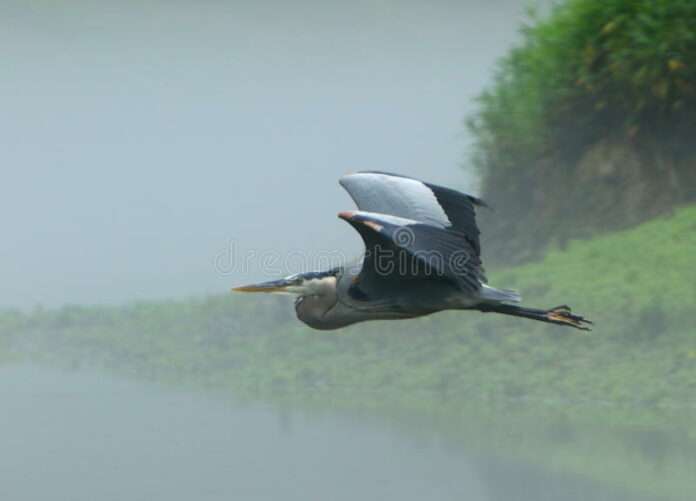I remember a turkey hunt along the river some years back and the discovery that it led us to. We had hunted along the river west of Inman, and parked near an adjacent alfalfa field. As we crawled into the pickup to leave, my wife pointed toward the treetops along the river and asked “Is there a bird in that nest?” I looked where she pointed, and saw a haphazard collection of twigs or something in the very top of a tall dead Cottonwood. The ensuing conversation went something like this: “No dear that looks like a squirrel’s nest to me.” “I don’t think so,” she replied, “and I’m sure that’s a bird in it.” “Here then,” I said, handing her the binoculars. “See for yourself.” “Just like I thought,” she answered. “That is a bird. It looks like one of those big tall birds we see wading along the river.” “A Blue Heron,” I corrected, “and I don’t think so; not way up there!” I snatched the binoculars from her, and peered at the “squirrels’ nest” high in the tree. Sure enough! Sticking out like a sore thumb in the tallest tree around was a large willy-nilly collection of branches and sticks, and square in the middle of it stood the unmistakable silhouette of a Great Blue Heron, better known as a “crane” to most of us. Now, had “mom heron” not been standing in her nest, the squirrels nest theory would certainly have “flown,” and we’d have never given the spectacle a second glance. When we left, we took the gravel road along the other side of the river, and stopped for another look. We found the nest to be hidden by green trees, but discovered yet a second nest in which we also found an adult heron a few days later. A trip to that spot along the river today revealed 7 heron nests in that tree alone, along with 3 adult herons, and as we drove farther up the road, several more nests could be seen in an adjacent tree.
Great Blue Herons of some subspecies or coloration exist across the entire continental United States and Alaska. For Kansas herons, southern migration to Mexico or South America begins in October where they winter until March. They are very tall, gangly birds with immense wingspans of up to six feet, yet weigh less than ten pounds. Depending upon conditions, a few awkward “steps” may be required to launch them into flight, but once in the air, they move with slow, rhythmic, effortless strokes of those immense wings. Unlike most birds of their stature, they fly with their necks crooked and folded back against their bodies and their heads held upright. They have practically no tail at all, so they also fly with their long legs straight out behind them, acting as rudders to help steer them in flight.
I’m sure we’ve all seen “cranes” fishing in rivers and streams and along the banks of ponds. Although fish, frogs and small snakes make up the vast majority of their diet, they are not above eating insects and small rodents also. Their long, pointed beaks are perfectly designed for stabbing prey, which is always killed and swallowed head first. The enzymes in their digestive system are so strong that most bone matter is completely dissolved.
Great Blue Herons demand isolation in their nesting sites, and are very sensitive to human disturbance. Nests are often found in colonies known as “heronries,” and can be anywhere from treetops like the ones we found, to rocky ledges and crevices on the ground. When satisfied with a nesting site, the birds usually return year after year to enlarge and reuse the same structures whenever possible. Three or four bluish-green eggs are laid and incubated for twenty-eight days by both parents. Research shows that heron chicks are extremely unpleasing to look at until fully feathered, and stay in the nest until they are nearly full-grown.
Great Blue Herons are far form rare, and I remember as a kid learning to know them as “cranes” as we watched them hunt around the edges of the farm pond where my dad took me to fish for bass and bullheads. Your grandparents no doubt knew them as “shitepokes.” Writing this piece showed me how little I really knew about these birds, especially about where they built their nests. Yet another reason to Explore Kansas Outdoors!
Steve can be contacted by email at [email protected].





